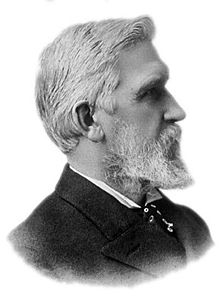Elisha Gray
Elisha Gray (born August 2, 1835 in Barnesville , Ohio , † January 21, 1901 in Newtonville , Massachusetts ) was an American teacher , inventor and entrepreneur .
Gray lost his father at the age of 12 and had to leave school early. He first learned the craft of blacksmith , carpenter and boat builder. In 1856 he entered Oberlin College in Ohio , where he studied physics for 5 years . He became a teacher at that institution and later at Ripon College in Wisconsin .
Services
Gray filed his first patent for a telegraphic device in 1867, which was followed by 50 others, mostly in the field of telephone and telegraph technology. In 1869, Gray moved to Cleveland , Ohio and founded an electrical goods company that was later relocated to Chicago and merged with the Western Electric Manufacturing Company to form the Western Electric Company . In 1878 Gray left the company to devote himself to his studies and the exploitation of his inventions, which were mainly relays and printing telegraphs.
In 1875 Gray began experiments with the electrical transmission of sounds, the result of which was laid down in a patent application. He did not receive this patent, however, because Alexander Graham Bell filed a patent application for the same object two hours before Gray. In a lawsuit, Gray and the Western Electric Company, allied with him, failed to enforce his claims against Bell.
Another of Gray's inventions is the teleautograph, demonstrated at the Chicago World's Fair in 1893 , and worked on improving it and developing an underwater sound signal system until he was the last of his life. Gray described the operation of the teleautograph, the forerunner of the modern fax machine, as follows:
“The writing apparatus at the point of departure can be placed on a simple desk or desk in any house, office, room into which a telegraphic or telephone wire line extends. An ordinary pencil is used for writing. At its tip, two silk cords are attached at right angles to each other, which, when connected to the device, follow the movement of the pencil exactly and electrically control the receiving pen at the other end of the line in a remote city, i.e. in the addressee's place of residence. The usual 5-inch-wide stationery on the loading station runs over a roller attached to the device and, similar to the well-known type writer or typewriter, is pushed forward electrically line by line by pressing a lever. At the receiving end of the addressee, two aluminum arms hold the hair-thin glass tube, continuously fed with ink, which serves as a pen for writing and, guided by the electric current from the sender of the message, moves simultaneously and in the same direction and expansion with every movement of the distant pencil at the exit end moved in such a way that their writing in ink is a very precise reproduction of what the author writes or records with the pencil at the end of the departure. Hand drawings, shorthand characters and other hieroglyphs can also be transmitted by wire. "
Since 1878 he was a member of the American Philosophical Society .
Publications - (incomplete)
- Nature's Miracles, Familiar Talks on Science. Vol II - Energy and Vibration
- NATURE'S MIRACLES, VOL. III. Electricity and Magnetism BY ELISHA GRAY, Ph.D., LL.D. PROJECT GUTENBERG EBOOK
Web links
- ELISHA GRAY - Biography
- Prof. Elisha Gray and the teleautograph transmitter and receiver - page 52–54 in: "Popular Science Monthly" Volume 44, November 1893
Individual evidence
- ^ E. Gray: Electrical Telegraph for Transmitting Musical Tones . U.S. Patent 166095, July 27, 1875, PDF
- ^ Member History: Elisha Gray. American Philosophical Society, accessed August 27, 2018 .
See also
| personal data | |
|---|---|
| SURNAME | Gray, Elisha |
| BRIEF DESCRIPTION | American teacher, inventor, and entrepreneur |
| DATE OF BIRTH | August 2, 1835 |
| PLACE OF BIRTH | Barnesville , Ohio |
| DATE OF DEATH | January 21, 1901 |
| Place of death | Newtonville , Massachusetts |
